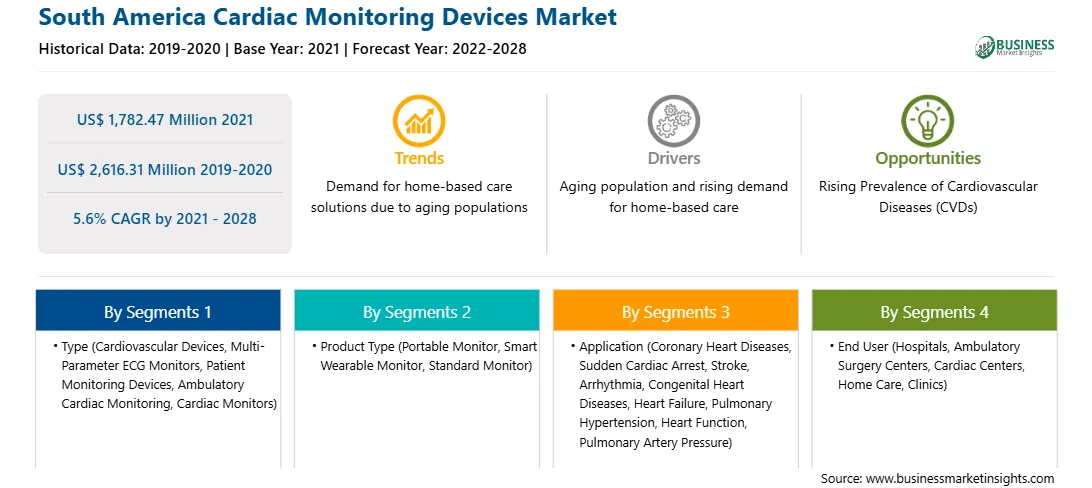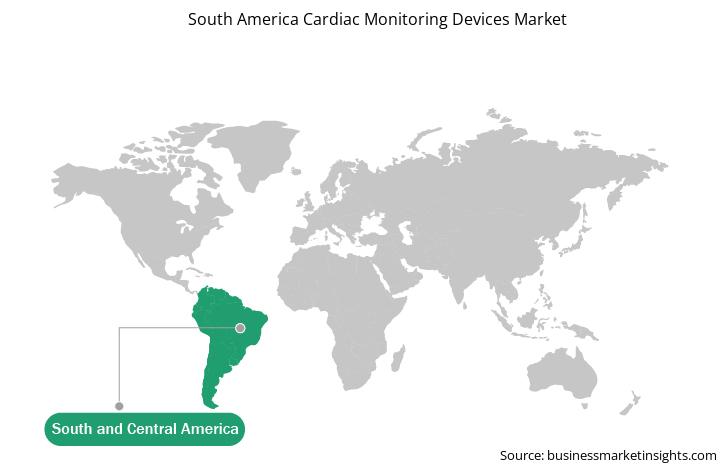Chile, Colombia, Peru, Cuba, Venezuela, and Bolivia are among the major countries contributing to the market's growth. The countries are improving their healthcare infrastructure by allowing new market players to enter for business. Therefore, it is expected to increase demand for cardiac monitoring devices in the coming years. In addition, SAM has a significant number of geriatric populations. According to the Organization for Economic Co-operation and Development (OECD), ~ 11.5% of population in Chile was reported to be over 60 years of age in 2018. Thus, the increasing geriatric population coupled with high prevalence of cardiovascular diseases and parallel development in the medical device technology and healthcare infrastructure in the region are likely to bolster the growth of the cardiac monitoring devices market during the forecast years.
Moreover, coronary heart disease is prevalent in Cuba due to individuals’ health habits, such as decreased physical activity with tobacco use, stress, and dietary behaviors. Additionally, a research study conducted in Colombia on heart failure showed that patients treated for heart failures were suffering from various diseases, such as valvular heart disease (10.5%) and hypertensive heart disease (12.2%). Moreover, many government, non-government, and public organizations are taking initiatives to increase the awareness among the population about heart problems. For instance, Invitae, a genetic information company, focused on bringing genetic information into mainstream medical practice to improve the quality of healthcare for billions of people across Chile, Colombia, Mexico, the US, Argentina, and Brazil. It helps improve diagnosis, offers free genetic testing and counseling for individuals suspected of having cardiomyopathy or arrhythmia, and provides risk stratification and management. The program called Detect Cardiomyopathy and Arrhythmia tests genes associated with inherited arrhythmia and cardiomyopathy conditions. Therefore, the above-mentioned factors are likely to offer growth opportunities for the SAM cardiac monitoring devices market during the forecast period.
With the new features and technologies, vendors can attract new customers and expand their footprints in emerging markets. This factor is likely to drive the SAM cardiac monitoring devices market in the coming years. The market is expected to grow at a good CAGR during the forecast period.
Strategic insights for the South America Cardiac Monitoring Devices provides data-driven analysis of the industry landscape, including current trends, key players, and regional nuances. These insights offer actionable recommendations, enabling readers to differentiate themselves from competitors by identifying untapped segments or developing unique value propositions. Leveraging data analytics, these insights help industry players anticipate the market shifts, whether investors, manufacturers, or other stakeholders. A future-oriented perspective is essential, helping stakeholders anticipate market shifts and position themselves for long-term success in this dynamic region. Ultimately, effective strategic insights empower readers to make informed decisions that drive profitability and achieve their business objectives within the market.

| Report Attribute | Details |
|---|---|
| Market size in 2021 | US$ 1,782.47 Million |
| Market Size by 2028 | US$ 2,616.31 Million |
| Global CAGR (2021 - 2028) | 5.6% |
| Historical Data | 2019-2020 |
| Forecast period | 2022-2028 |
| Segments Covered |
By Type
|
| Regions and Countries Covered | South and Central America
|
| Market leaders and key company profiles |
The geographic scope of the South America Cardiac Monitoring Devices refers to the specific areas in which a business operates and competes. Understanding local distinctions, such as diverse consumer preferences (e.g., demand for specific plug types or battery backup durations), varying economic conditions, and regulatory environments, is crucial for tailoring strategies to specific markets. Businesses can expand their reach by identifying underserved areas or adapting their offerings to meet local demands. A clear market focus allows for more effective resource allocation, targeted marketing campaigns, and better positioning against local competitors, ultimately driving growth in those targeted areas.

The MEA cardiac monitoring devices market is segmented on the basis of type, product type, application, end user, and country. Based on type, the market is segmented into cardiovascular devices, multi-parameter ECG monitors, patient monitoring devices, ambulatory cardiac monitoring, and cardiac monitors. In 2020, the cardiovascular devices segment held the largest share of the market. Based on product type, the MEA cardiac monitoring devices market is segmented into portable monitor, smart wearable monitor, and standard monitor. In 2020, the standard monitor segment held the largest share of the market. Based on application, the market is segmented into coronary heart diseases, sudden cardiac arrest, stroke, arrhythmia, congenital heart diseases, heart failure, pulmonary hypertension, heart function (HF/LVEDP), pulmonary artery pressure (PA), and others. The coronary heart diseases segment held the largest market share in 2020 and is expected to be the largest shareholder in the market by 2028. Based on end user, the MEA cardiac monitoring devices market is segmented into hospitals, ambulatory surgery centers (ASCs), and clinics. The hospitals segment held the largest market share in 2020. Based on country, the SAM cardiac monitoring devices market is segmented into Brazil, Argentina, and the rest of SAM. Abbott; AliveCor, Inc; Amiitalia; Asahi Kasei Corporation; Biotronik, Inc.; Boston Scientific Corporation; BTL; GE Healthcare; Hill-Rom Holdings, Inc.; Infinium Medical; Koninklijke Philips N.V.; LivaNova PLC; Medtronic; Nihon Kohden Corporation; MicroPort Scientific Corporation; SCHILLER Healthcare India Pvt. Ltd; and Shenzhen Mindray Bio-Medical Electronics Co., Ltd. are among the leading companies in the market.
The South America Cardiac Monitoring Devices Market is valued at US$ 1,782.47 Million in 2021, it is projected to reach US$ 2,616.31 Million by 2028.
As per our report South America Cardiac Monitoring Devices Market, the market size is valued at US$ 1,782.47 Million in 2021, projecting it to reach US$ 2,616.31 Million by 2028. This translates to a CAGR of approximately 5.6% during the forecast period.
The South America Cardiac Monitoring Devices Market report typically cover these key segments-
The historic period, base year, and forecast period can vary slightly depending on the specific market research report. However, for the South America Cardiac Monitoring Devices Market report:
The South America Cardiac Monitoring Devices Market is populated by several key players, each contributing to its growth and innovation. Some of the major players include:
The South America Cardiac Monitoring Devices Market report is valuable for diverse stakeholders, including:
Essentially, anyone involved in or considering involvement in the South America Cardiac Monitoring Devices Market value chain can benefit from the information contained in a comprehensive market report.